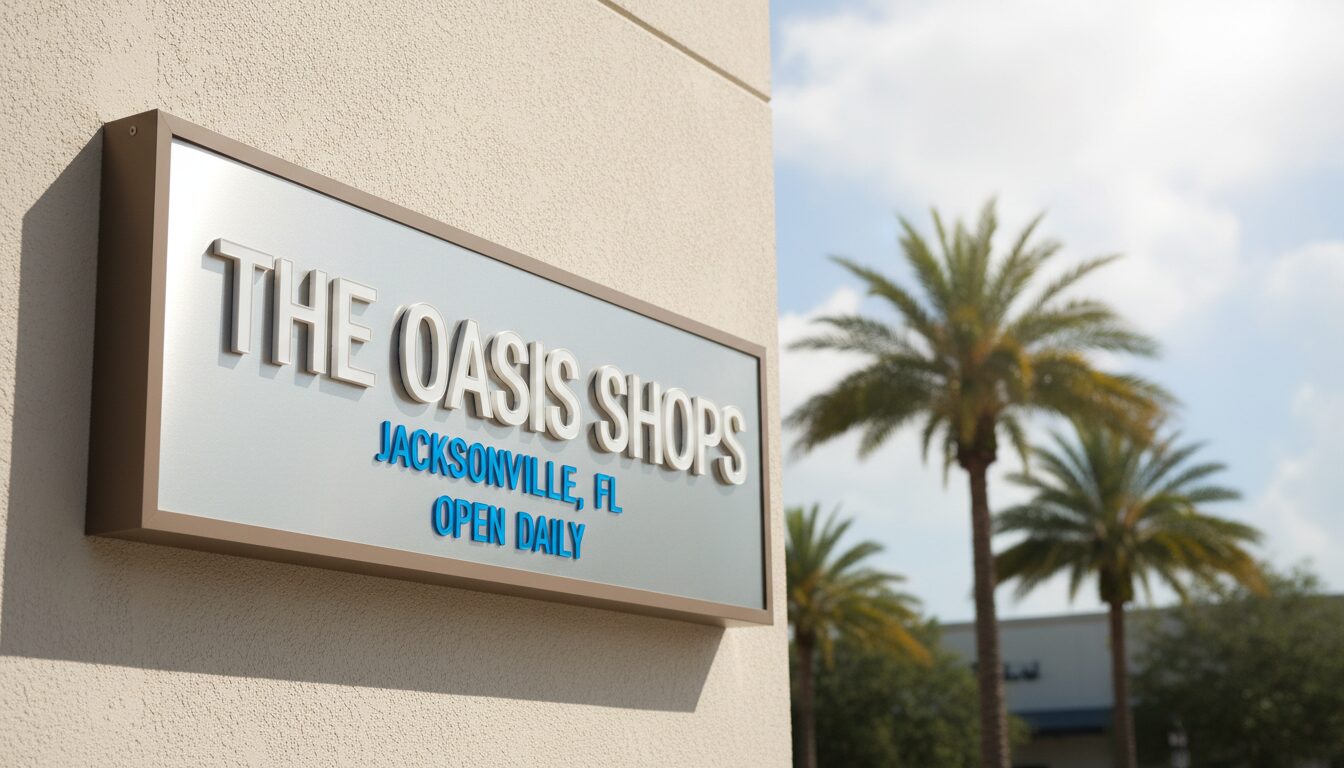Your signage creates customer impressions long before any sales conversation begins. Within seconds of seeing your business sign, potential customers form judgments about your company’s professionalism, quality, and trustworthiness that influence every subsequent interaction they have with your brand.
This psychological process happens automatically and subconsciously, making signage one of the most powerful – yet often underestimated – tools in your branding arsenal. The visual messages your signage communicates extend far beyond basic identification, actively shaping customer expectations, purchase decisions, and long-term brand loyalty.
Understanding how signage influences customer perception enables business owners to make strategic decisions about design, placement, and messaging that reinforce desired brand attributes while avoiding visual cues that might undermine their intended market positioning.
The Psychology of First Impressions Through Signage
Customer perception formation occurs within milliseconds of visual contact, with signage often serving as the primary information source for these critical first impressions. Research in cognitive psychology demonstrates that people make rapid judgments about businesses based on visual cues, with these initial assessments proving remarkably resistant to change through subsequent experiences.
Visual Processing Speed means customers evaluate your business quality, professionalism, and trustworthiness before consciously deciding to examine your signage in detail. This subconscious evaluation process draws on established psychological associations between visual elements and quality perceptions that operate consistently across different demographic groups.
Color combinations, typography choices, material quality, and overall design execution all contribute to immediate quality assessments that customers make about your business. Premium materials and professional design execution create associations with quality and reliability, while poor construction or design choices can undermine customer confidence before any direct interaction occurs.
Cognitive Anchoring explains how initial visual impressions establish baseline expectations that influence interpretation of all subsequent customer experiences. When customers see high-quality signage, they expect corresponding quality in products, services, and customer experience throughout their interaction with your business.
This anchoring effect works bidirectionally – impressive signage elevates expectations while creating positive bias toward your business, while poor signage creates negative expectations that require additional effort to overcome through exceptional service or product quality.
Brand Association Formation happens automatically as customers connect visual elements of your signage with existing knowledge, experiences, and preferences stored in their memory. These associations can reinforce intended brand positioning or create unintended perceptions that conflict with your marketing strategy.
Professional, well-maintained signage creates associations with established, reliable businesses that customers can trust with important purchases or ongoing relationships. Conversely, dated, damaged, or poorly designed signage may create associations with businesses that lack attention to detail or sufficient resources to maintain professional standards.

Visual Elements That Drive Customer Perception
Specific design elements within your signage communicate distinct messages about your brand identity, with customers interpreting these visual cues according to learned cultural associations and personal experiences that influence their perception of your business quality and positioning.
Typography Psychology reveals how font choices communicate personality traits and quality levels that customers attribute to your business. Serif fonts often convey tradition, reliability, and established authority, while sans-serif fonts suggest modernity, efficiency, and forward-thinking approaches.
Custom lettering or unique typography creates distinctiveness that helps businesses stand out while reinforcing brand personality. However, overly decorative or difficult-to-read fonts can create negative impressions about professionalism or customer consideration, potentially undermining intended brand messages.
Typography hierarchy within signage also influences perception, with clear information organization suggesting business efficiency and customer focus, while cluttered or poorly organized text can create impressions of disorganization or lack of strategic thinking.
Color Psychology Impact operates through both universal associations and cultural learning that influence customer emotional responses and quality perceptions. Certain color combinations consistently evoke specific emotional responses that customers transfer to their perception of your business.
Blue tones often create associations with trust, reliability, and professionalism, making them popular choices for financial services, healthcare, and technology businesses. Red can suggest energy, urgency, or excitement but may also create associations with discount pricing that conflicts with premium positioning strategies.
Color consistency across signage elements reinforces brand recognition while creating impressions of attention to detail and professional brand management. Inconsistent color usage or poor color reproduction can suggest lack of quality control or insufficient investment in brand presentation.
Material Quality Perception influences customer assumptions about business investment, longevity, and commitment to quality that extend beyond signage to encompass overall business operations and product quality expectations.
Premium materials such as brushed aluminum, quality acrylics, or professionally finished wood create associations with established, successful businesses that invest in long-term quality rather than short-term cost savings. These material choices suggest businesses that apply similar quality standards to their products or services.
Conversely, obviously inexpensive materials or visible wear and deterioration can create negative impressions about business priorities, financial stability, or commitment to maintaining professional standards that customers expect from businesses they choose to patronize.
Lighting Quality and Effects contribute significantly to perception formation, with professional lighting creating associations with established businesses while poor or inadequate lighting can suggest budget constraints or lack of attention to customer experience.
Consistent, even lighting suggests technical competence and attention to detail, while flickering, dim, or harsh lighting creates negative associations that customers may transfer to expectations about product quality or service reliability.
Dynamic lighting effects, when executed professionally, can create positive associations with innovation and success, though poorly implemented lighting effects may create negative impressions about business judgment or technical competence.
Signage Impact on Trust and Credibility
Trust formation represents one of the most critical aspects of customer perception, with signage playing a fundamental role in establishing credibility that influences customer willingness to engage with your business, share personal information, or make significant purchases.
Professional Appearance Standards create immediate credibility assessments that customers use to evaluate business trustworthiness. Well-designed, properly maintained signage suggests businesses that maintain professional standards throughout their operations.
Attention to details such as proper spelling, accurate information, and consistent branding creates impressions of competence and reliability that customers associate with businesses they can trust with important purchases or ongoing relationships.
Professional installation quality also influences credibility assessments, with signs that appear properly mounted, level, and structurally sound creating confidence in business competence and attention to important details.
Information Clarity and Accuracy demonstrates respect for customer needs while building confidence in business reliability. Clear, accurate signage information suggests businesses that prioritize customer convenience and maintain accurate information across all business communications.
Operating hours, contact information, service descriptions, and pricing information presented clearly and accurately builds customer confidence while reducing uncertainty that might prevent initial engagement or purchase decisions.
Outdated or inaccurate information creates negative impressions about business organization and reliability that can undermine customer confidence even when actual products or services meet or exceed expectations.
Consistency Across Brand Touchpoints reinforces credibility through demonstrating brand management competence and attention to detail that customers associate with reliable business operations.
When signage design, messaging, and quality standards align with other brand elements such as website design, business cards, or vehicle graphics, customers perceive professional brand management that suggests competence in business operations.
Inconsistency across brand touchpoints can create uncertainty about business professionalism or attention to detail that may cause customers to question reliability in more important areas such as product quality or service delivery.
Industry-Specific Perception Factors
Different industries create specific customer expectations about signage design and quality that influence perception formation, with customers applying industry-specific standards when evaluating business credibility and quality through visual presentation.
Professional Services Expectations typically require sophisticated, understated signage that conveys competence and reliability without appearing flashy or promotional. Legal offices, accounting firms, and consulting businesses benefit from signage that suggests stability, expertise, and professional discretion.
Clean typography, premium materials, and conservative design choices often work better for professional services than bold, attention-grabbing approaches that might suggest advertising focus rather than professional competence.
Retail Environment Standards allow for more dynamic, attention-grabbing signage approaches while still requiring quality execution that builds customer confidence in product quality and business reliability.
Retail signage can incorporate more color, movement, and promotional elements while maintaining professional appearance standards that reassure customers about business quality and purchase security.
Healthcare and Medical Signage requires particular attention to cleanliness, professionalism, and information clarity that builds patient confidence in medical competence and facility quality standards.
Healthcare signage often benefits from incorporating elements that suggest cleanliness, precision, and patient care focus through design choices that reinforce medical professionalism and attention to patient needs.
Restaurant and Food Service signage must balance appetite appeal with cleanliness and quality impressions that influence customer confidence in food safety and preparation standards.
Food service signage often incorporates elements that suggest freshness, quality ingredients, and attention to food safety through design choices that build customer confidence in dining experience quality.
Digital vs. Traditional Signage Perception
The choice between digital and traditional signage formats influences customer perception differently, with each approach creating distinct associations that may align better with specific brand positioning strategies or customer demographics.
Digital Signage Associations often create impressions of innovation, technological competence, and forward-thinking business approaches that appeal to customers who value modern technology and efficiency.
Professional digital displays suggest businesses that invest in current technology and maintain systems that provide customer convenience through real-time information and dynamic content capabilities.
However, poor quality digital displays or outdated content can create negative impressions about technical competence or business maintenance standards that may undermine intended modernization benefits.
Traditional Signage Reliability creates associations with established businesses, permanence, and classic quality standards that appeal to customers who value stability and traditional business approaches.
High-quality traditional signage often suggests businesses with long-term commitment to their location and customer base, creating confidence in business stability and ongoing service availability.
Traditional materials such as carved wood, etched glass, or quality metal fabrication can create premium associations that reinforce positioning for businesses emphasizing craftsmanship, tradition, or established expertise.
Hybrid Approaches combine elements of both digital and traditional signage to create balanced impressions that appeal to diverse customer preferences while demonstrating both innovation and stability.
Successful hybrid approaches often use traditional materials for primary identification while incorporating digital elements for variable information such as hours, specials, or current promotions.
Measuring Signage Impact on Brand Perception
Understanding how signage influences customer perception requires systematic evaluation methods that provide objective feedback about the effectiveness of design choices and their impact on desired brand associations.
Customer Feedback Collection provides direct insights into how signage influences customer impressions and purchase decisions. Simple questions about how customers learned about your business or what influenced their decision to visit can reveal signage effectiveness.
Online reviews sometimes mention signage impact on customer decision-making, providing unsolicited feedback about how visual presentation influences customer perception and experience expectations.
Brand Recognition Testing evaluates how effectively signage communicates intended brand messages and creates desired associations in customer minds. This testing can reveal gaps between intended brand positioning and actual customer perception.
Traffic Pattern Analysis helps determine whether signage successfully attracts customer attention and generates desired business traffic, providing measurable feedback about visual impact and customer response.
Competitive Analysis reveals how your signage compares to industry standards and competitor approaches, helping identify opportunities for differentiation or areas where perception improvements might provide competitive advantages.
Frequently Asked Questions About Signage and Brand Perception
How quickly do customers form impressions based on signage?
Research suggests customers form initial impressions within milliseconds of seeing signage, with these rapid assessments significantly influencing subsequent interactions and purchase decisions. These first impressions prove remarkably resistant to change, making initial signage impact critically important.
Can poor signage damage an otherwise good business reputation?
Yes, signage quality significantly influences customer perception of overall business quality and professionalism. Poor signage can create negative expectations that require exceptional service or products to overcome, while excellent signage creates positive bias that enhances customer experience.
Do different customer demographics respond differently to signage design?
While certain psychological principles operate consistently across demographics, specific design preferences, color associations, and style preferences can vary among different age groups, cultural backgrounds, and income levels. Understanding your target demographic helps optimize signage design for maximum positive impact.
How does signage location affect perception impact?
Signage placement influences both visibility and context, with prominent locations creating stronger impression impact while context influences interpretation. Signage in upscale areas may be evaluated by different standards than similar signage in budget-focused commercial areas.
Can businesses recover from negative first impressions created by poor signage?
While possible, overcoming negative first impressions requires considerable effort and exceptional customer experience. Investing in quality signage from the beginning proves more cost-effective than attempting to overcome negative perceptions through superior service or product quality.
How often should businesses evaluate signage impact on brand perception?
Regular evaluation helps ensure signage continues supporting desired brand positioning as markets evolve and customer expectations change. Annual reviews typically provide sufficient frequency unless significant business changes or market shifts warrant more frequent assessment.
Optimizing Signage for Desired Brand Perception
Creating signage that effectively shapes customer perception requires strategic thinking about desired brand associations and systematic implementation of design elements that reinforce intended positioning while avoiding visual cues that might create conflicting impressions.
Understanding the psychological principles behind perception formation enables businesses to make informed decisions about signage investments that support long-term brand building rather than just immediate visibility needs.
The most effective signage strategies align visual elements with intended brand positioning while meeting industry expectations and customer preferences that influence perception formation and purchase decisions.
Ready to ensure your signage creates the brand perception that drives business success? Contact SignLab JAX today to discuss how strategic signage design can shape customer perception to support your brand positioning and business objectives.




